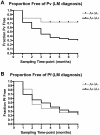Reduced Plasmodium vivax erythrocyte infection in PNG Duffy-negative heterozygotes
- PMID: 17389925
- PMCID: PMC1829178
- DOI: 10.1371/journal.pone.0000336
Reduced Plasmodium vivax erythrocyte infection in PNG Duffy-negative heterozygotes
Abstract
Background: Erythrocyte Duffy blood group negativity reaches fixation in African populations where Plasmodium vivax (Pv) is uncommon. While it is known that Duffy-negative individuals are highly resistant to Pv erythrocyte infection, little is known regarding Pv susceptibility among heterozygous carriers of a Duffy-negative allele (+/-). Our limited knowledge of the selective advantages or disadvantages associated with this genotype constrains our understanding of the effect that interventions against Pv may have on the health of people living in malaria-endemic regions.
Methods and findings: We conducted cross-sectional malaria prevalence surveys in Papua New Guinea (PNG), where we have previously identified a new Duffy-negative allele among individuals living in a region endemic for all four human malaria parasite species. We evaluated infection status by conventional blood smear light microscopy and semi-quantitative PCR-based strategies. Analysis of a longitudinal cohort constructed from our surveys showed that Duffy heterozygous (+/-) individuals were protected from Pv erythrocyte infection compared to those homozygous for wild-type alleles (+/+) (log-rank tests: LM, p = 0.049; PCR, p = 0.065). Evaluation of Pv parasitemia, determined by semi-quantitative PCR-based methods, was significantly lower in Duffy +/- vs. +/+ individuals (Mann-Whitney U: p = 0.023). Overall, we observed no association between susceptibility to P. falciparum erythrocyte infection and Duffy genotype.
Conclusions: Our findings provide the first evidence that Duffy-negative heterozygosity reduces erythrocyte susceptibility to Pv infection. As this reduction was not associated with greater susceptibility to Pf malaria, our in vivo observations provide evidence that Pv-targeted control measures can be developed safely.
Conflict of interest statement
Figures



Similar articles
-
Plasmodium vivax infection in Anajás, State of Pará: no differential resistance profile among Duffy-negative and Duffy-positive individuals.Malar J. 2012 Dec 22;11:430. doi: 10.1186/1475-2875-11-430. Malar J. 2012. PMID: 23259672 Free PMC article.
-
Plasmodium vivax clinical malaria is commonly observed in Duffy-negative Malagasy people.Proc Natl Acad Sci U S A. 2010 Mar 30;107(13):5967-71. doi: 10.1073/pnas.0912496107. Epub 2010 Mar 15. Proc Natl Acad Sci U S A. 2010. PMID: 20231434 Free PMC article.
-
Transmission of Plasmodium vivax in Duffy-negative individuals in central Sudan.Trans R Soc Trop Med Hyg. 2016 Apr;110(4):258-60. doi: 10.1093/trstmh/trw014. Trans R Soc Trop Med Hyg. 2016. PMID: 27076512
-
Red blood cell polymorphism and susceptibility to Plasmodium vivax.Adv Parasitol. 2013;81:27-76. doi: 10.1016/B978-0-12-407826-0.00002-3. Adv Parasitol. 2013. PMID: 23384621 Free PMC article. Review.
-
Plasmodium vivax in Africa: hidden in plain sight?Trends Parasitol. 2007 May;23(5):193-6. doi: 10.1016/j.pt.2007.02.009. Epub 2007 Mar 13. Trends Parasitol. 2007. PMID: 17360237 Review.
Cited by
-
Population genetic analysis of the DARC locus (Duffy) reveals adaptation from standing variation associated with malaria resistance in humans.PLoS Genet. 2017 Mar 10;13(3):e1006560. doi: 10.1371/journal.pgen.1006560. eCollection 2017 Mar. PLoS Genet. 2017. PMID: 28282382 Free PMC article.
-
The epidemiology of Plasmodium falciparum and Plasmodium vivax in East Sepik Province, Papua New Guinea, pre- and post-implementation of national malaria control efforts.Malar J. 2020 Jun 5;19(1):198. doi: 10.1186/s12936-020-03265-x. Malar J. 2020. PMID: 32503607 Free PMC article.
-
Plasmodium vivax From Duffy-Negative and Duffy-Positive Individuals Share Similar Gene Pools in East Africa.J Infect Dis. 2021 Oct 28;224(8):1422-1431. doi: 10.1093/infdis/jiab063. J Infect Dis. 2021. PMID: 33534886 Free PMC article.
-
Progress towards the development of a P. vivax vaccine.Expert Rev Vaccines. 2021 Feb;20(2):97-112. doi: 10.1080/14760584.2021.1880898. Epub 2021 Mar 4. Expert Rev Vaccines. 2021. PMID: 33481638 Free PMC article. Review.
-
FY polymorphisms and vivax malaria in inhabitants of Amazonas State, Brazil.Parasitol Res. 2010 Apr;106(5):1049-53. doi: 10.1007/s00436-010-1745-x. Epub 2010 Feb 17. Parasitol Res. 2010. PMID: 20162434
References
-
- Muller I, Bockarie M, Alpers M, Smith T. The epidemiology of malaria in Papua New Guinea. Trends Parasitol. 2003;19:253–9. - PubMed
-
- Bruce MC, Donnelly CA, Alpers MP, Galinski MR, Barnwell JW, et al. Cross-species interactions between malaria parasites in humans. Science. 2000;287:845–8. - PubMed
-
- Mayxay M, Pukrittayakamee S, Newton PN, White NJ. Mixed-species malaria infections in humans. Trends Parasitol. 2004;20:233–40. - PubMed
-
- Snounou G. Cross-species regulation of Plasmodium parasitaemia cross-examined. Trends Parasitol. 2004;20:262–5; discussion 266–7. - PubMed
Publication types
MeSH terms
Substances
Grants and funding
LinkOut - more resources
Full Text Sources
Molecular Biology Databases
Research Materials

